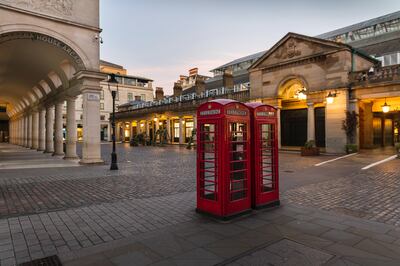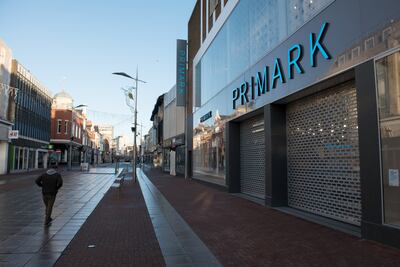
The Business of Fashion
Agenda-setting intelligence, analysis and advice for the global fashion community.

Agenda-setting intelligence, analysis and advice for the global fashion community.
On a chilly winter afternoon, one of the few signs of life at the Colosseum Retail Park in suburban north London is an elderly woman smoking outside the bingo hall, protective face visor slung over one arm.
The BlackRock Inc.-owned centre on the edge of a highway is now marked for demolition to make way for up to 1,800 homes in a group of apartment towers. It’s just one of more than 80 current projects in the capital where landlords are seeking to turn dated properties into mass housing blocks — a big leap from the past decade when only seven such developments were built.
“They’re putting up flats wherever they can,” said Brenda Calkin, 73, who was visiting Buzz Bingo in Enfield twice a week with her sisters before the latest lockdown. “It’s not fair because there’s not many bingo halls around for older people to go to, is there? We don’t get much entertainment as it is.”
Half an hour’s walk away, shoppers at another mall are greeted with empty stores and offers of 50 percent discounts, while the benches they once rested on are now sealed off with hazard tape. DWS Group, the asset-management firm majority-owned by Deutsche Bank AG, is proposing to transform the 1980s building into a complex that includes a 26-story housing block.
ADVERTISEMENT
Saddled with commercial properties battered by the pandemic, some of the world’s biggest investors are making a wager: apartment living will make more of a post-Covid comeback than in-person retail.
Some of the world’s biggest investors are making a wager: apartment living will make more of a post-Covid comeback than in-person retail.
The bet has London’s housing shortage and high residential property values on its side. But apartment rents and sales have plunged in the capital as the pandemic spurred an exodus of Londoners seeking greenery and space, while residents have also been spooked by safety fears after the 2017 Grenfell Tower fire.
“There’s certainly a lot of them being built — I don’t think that reflects a burning demand in the marketplace for living in high-density housing,” said Kath Scanlon, a distinguished policy fellow at the London School of Economics. “Everything that’s happened in the last year is a real challenge for that model of development,” she said.
For many landlords, 2020 was an unwelcome wake-up call. While office owners winced at the creeping adoption of long-term work-from-home policies, retail properties were hammered as the pandemic supercharged the shift toward online shopping. Stores are emptying at the fastest pace on record, and the resulting surplus of physical shops has spurred some owners to maximise space — and profits — by building up.

There are currently 82 examples in London of complexes of at least 1,000 homes that are either in the planning stages or underway, according to researcher Molior London. Not all of them will be sprouting up in the near-term, and some won’t materialise at all if they fail to get permission.
Still, it’s likely that swathes of London will have a new skyline by the end of this decade.
Dutch pensions giant APG Asset Management NV is among investors planning apartments on the site of the recently demolished Elephant and Castle shopping centre, part of a major regeneration that’s been resisted by the area’s long-time residents for years. On Old Kent Road, the first property square on the British version of the Monopoly board game, consent has been given for more than 8,000 homes on and around the south London thoroughfare.
“It’s helping hold values, knowing that we’ve got the potential to convert to residential,” said Jonathan Bayfield, head of UK real estate research for Aviva Investors, which has the green light to convert a retail park on Old Kent Road into a complex including a 48-story apartment block.
ADVERTISEMENT
There’s a crucial catch to all these plans: London apartments haven’t been a safe bet for some time. Some large builders, such as Crest Nicholson Holdings Plc and Redrow Plc, began pulling out of the capital in recent years as houses became increasingly unaffordable, while others resorted to bulk sales to shift unwanted homes. Developers will also be relying on rents recovering — they slumped an annual 6.4 percent in London at the end of 2020, according to property website Rightmove, even while soaring to record highs across the rest of the country.
It’s helping hold values, knowing that we’ve got the potential to convert to residential.
The public mood has also soured against high-rise tower blocks after apartment owners in thousands of buildings across the country found out their homes were structurally unsafe, and that they would probably have to pick up the bills for repairs. The growing focus on dangerous buildings comes in the wake of the Grenfell Tower disaster in 2017, when a fire that spread on the building’s flammable cladding caused 72 deaths.
To be sure, rental housing has proven a popular strategy for major real estate investors through the pandemic as they bet on the relatively stable income it provides even in periods of volatility. Greystar Real Estate Partners LLC, the U.S. private equity firm that specialises in all forms of rental housing, raised a record $6 billion in 2020, according to executive managing director of investment management Wes Fuller.
Investors are also betting that some of the London’s cash-strapped boroughs will welcome the flood of apartments, even as many residents oppose the potential impact on local infrastructure. The borough of Newham, which helped host the 2012 Olympics, accounts for about 10 percent of London’s current large developments, despite being one of the city’s poorest boroughs.

“You do get these very concentrated developments of high density schemes taking place around where people have lower incomes,” said Anthony Breach, an analyst at Centre for Cities. “Very little development is allowed in the vast majority of London’s urban area, including where lots of middle class people and homeowners live.”
One south London suburb offers a potential glimpse into the future. Croydon is one of the most affordable areas in the capital and homes are being built at a speed which outpaces much of the city, with towers taking up much of the suburb’s skyline. The suburb was also tarnished by a “micro-apartment” boom, where changes to planning laws allowed developers to convert office buildings into units as small as 10 square meters.
Mass development hasn’t lifted the fortunes of Croydon, where the high street was dotted with shuttered stores and empty properties during lockdown. Unibail-Rodamco-Westfield and Hammerson Plc’s plans to jointly build a new shopping mall have stalled.
Back in north London, residents are wary. Community group the Enfield Society has already voiced concerns that its suburb could become the next Croydon, thanks to the scale of projects underway from the likes of BlackRock and DWS.
ADVERTISEMENT
“We understand there will always be concerns, but this is exactly the type of location that does seem appropriate for putting the housing density in,” Paul Tebbit, managing director of the BlackRock UK Property Fund, said in an interview. “Obviously there will be things that will be lost, but everything is a compromise.”
By Olivia Konotey-Ahulu.
Related Articles:
Antitrust enforcers said Tapestry’s acquisition of Capri would raise prices on handbags and accessories in the affordable luxury sector, harming consumers.
As a push to maximise sales of its popular Samba model starts to weigh on its desirability, the German sportswear giant is betting on other retro sneaker styles to tap surging demand for the 1980s ‘Terrace’ look. But fashion cycles come and go, cautions Andrea Felsted.
The rental platform saw its stock soar last week after predicting it would hit a key profitability metric this year. A new marketing push and more robust inventory are the key to unlocking elusive growth, CEO Jenn Hyman tells BoF.
Nordstrom, Tod’s and L’Occitane are all pushing for privatisation. Ultimately, their fate will not be determined by whether they are under the scrutiny of public investors.